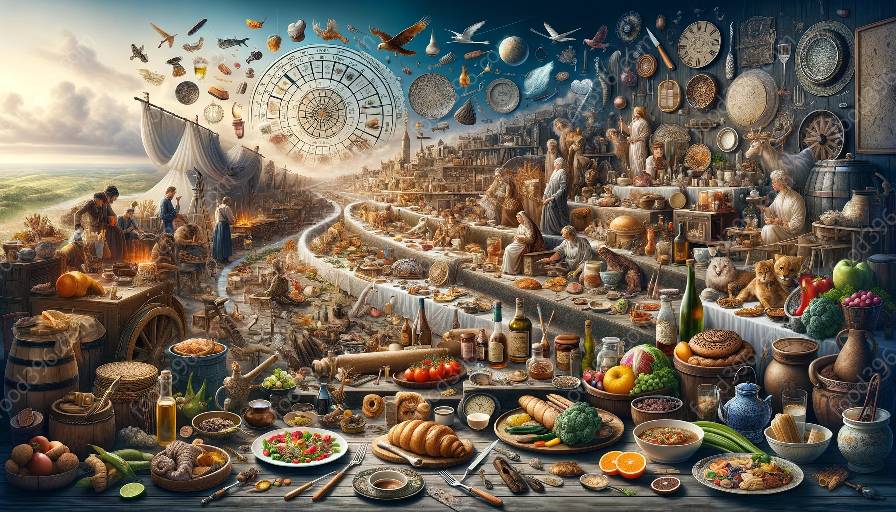Chinese cuisine boasts a rich history that spans several millennia, and its cooking methods have undergone significant developments over the years. In this exploration, we delve into the historical evolution of Chinese cooking methods, taking a closer look at the key developments that have shaped the culinary traditions of China.
Early Culinary Practices
The roots of Chinese cooking methods can be traced back to ancient times, characterized by the use of simple techniques and a focus on preserving the natural flavors of ingredients. Early cooking methods revolved around the use of basic tools such as woks, steamers, and clay pots, which are still integral to Chinese culinary practices today. Heating methods included stir-frying, steaming, and boiling, laying the foundation for the diverse array of cooking techniques that define Chinese cuisine.
Impact of Dynastic Periods
The evolution of Chinese cooking methods was heavily influenced by the different dynastic periods in the country's history. Each dynasty brought its own culinary customs and preferences, contributing to the varied regional cuisines found in China today. For example, the Han dynasty introduced the use of fermented sauces and seasonings, while the Tang dynasty emphasized intricate food preparation and presentation, setting the stage for the artful culinary style associated with Chinese cuisine.
Introduction of Regional Variations
As Chinese civilization expanded, diverse regional cooking styles emerged, giving rise to distinct culinary traditions across the country. The culinary customs of areas such as Sichuan, Canton, and Shandong showcased unique ingredients and cooking methods, further enriching the tapestry of Chinese cuisine. The utilization of local produce and indigenous cooking techniques became integral to each region's culinary identity, underscoring the significance of regional variations in Chinese cooking methods.
Influence of Philosophical and Cultural Beliefs
The philosophies and cultural beliefs that permeated Chinese society also left a profound imprint on its culinary practices. Confucian principles of balance and harmony, coupled with the Taoist emphasis on natural flavors and medicinal ingredients, guided the development of Chinese cooking methods. The emphasis on achieving a harmonious blend of flavors and textures, as well as the use of food for its medicinal properties, became integral to traditional Chinese culinary practices, contributing to the holistic approach to cooking methods.
Impact of Trade and Global Exchange
China's engagement in trade and global exchange significantly impacted its cooking methods, leading to the incorporation of foreign ingredients and culinary techniques. The Silk Road facilitated the exchange of spices, fruits, and vegetables, introducing new flavors and ingredients that revolutionized Chinese cuisine. Additionally, trade interactions with neighboring countries such as India and Southeast Asian nations influenced the use of spices, seasonings, and cooking methods, contributing to the evolution of Chinese cooking techniques.
Revolution in Modern Times
With the advent of modernization and technological advancements, Chinese cooking methods experienced a revolution, leading to the adoption of innovative techniques and equipment. The introduction of gas stoves, electric steamers, and specialized kitchen utensils modernized traditional cooking practices, enabling greater efficiency and precision in Chinese culinary preparations. Furthermore, the fusion of traditional methods with contemporary culinary trends has given rise to a new wave of Chinese gastronomy, showcasing a blend of tradition and innovation.
Global Influence and Innovation
Chinese cuisine has had a profound impact on culinary traditions worldwide, leading to the integration of Chinese cooking methods in diverse international cuisines. The widespread popularity of Chinese dishes and cooking styles has sparked a global culinary fusion, inspiring chefs and food enthusiasts to incorporate elements of Chinese cooking into their own culinary creations. This cross-cultural exchange has fostered innovation and experimentation, further propelling the evolution of Chinese cooking methods on a global scale.
Preservation of Culinary Heritage
Despite the evolution and modernization of Chinese cooking methods, there remains a concerted effort to preserve the rich culinary heritage that defines Chinese cuisine. Traditional cooking techniques, such as wok hei (breath of the wok) and double boiling, continue to be revered and passed down through generations, maintaining a vital link to the historical legacy of Chinese culinary practices.
Conclusion
The historical developments in Chinese cooking methods offer a captivating journey through the culinary evolution of one of the world's most esteemed gastronomic traditions. From ancient culinary practices to modern innovations, the intricate tapestry of Chinese cooking methods reflects the profound cultural, historical, and philosophical influences that have shaped the diverse and vibrant landscape of Chinese cuisine.

